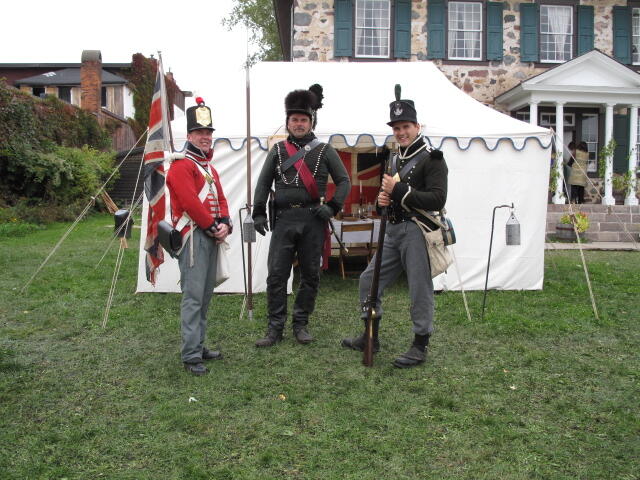
Sault Ste. Marie and the War of 1812

It may not be a well known fact, but Sault Ste. Marie, Ontario was on the front line of the War of 1812, a conflict that defined the future makeup of the North American continent.
Believe it or not, Sault Ste. Marie has been at the centre of the Canadian experience for over three centuries.
Two hundred years ago, the land, now known as the “Twin Soos” on either side of the Canada-U.S. border was a crucial junction of the lucrative fur trade, which had opened up the Great Lakes to British and French explorers as they competed for business with the native Ojibway population. The waterways of Lakes Huron, Michigan and Superior, with their bottlenecks and extensive shorelines, were a key territory for commerce. But a showdown between Great Britain and the newly formed United States was looming, and the inland seas and forests of Upper Canada were to be among the contested prizes.
In 1812, communication was a matter of months or weeks rather than the minutes and seconds of today. So when the vulnerable young American republic declared war on Britain on June 18, news did not reach the far-flung settlements of the British colony or the U.S. territories for some time. On St. Joseph’s Island in Lake Huron’s North Channel, Captain Charles Roberts’ isolated British outpost at Fort St. Joseph received early word of the impending clash, and Roberts decided to strike before his American enemies could prepare for battle.
Roberts assembled a ragtag crew of British soldiers, along with the area’s French voyageurs, Métis residents, and native warriors, and set southward, with the Northwest Company ship Caledonia leading an armada of canoes and small vessels. On July 17, the men stormed the American Fort Michilimackinac on what is now Mackinac Island, taking the garrison – unaware war had broken out – completely by surprise. Not a shot was fired as the American servicemen laid down their arms. The British secured the key position for the rest of the struggle. This was the first action of the War of 1812.
The War of 1812 resulted in the political division of North America as we now know it. British forces and local militias repelled American intrusions along the Great Lakes and captured important bases like Fort Michilimackinac, while the destruction of frontier and inland towns wrought on either side of the line strengthened senses of national identity (“The Star-Spangled Banner,” the U.S. national anthem, commemorates the British bombardment of Baltimore in 1814).
At the Battle of Chateauguay, south of Montreal, a mixed British, French, and First Nations division fought off an attack by a much larger U.S. army. The names of Isaac Brock and Laura Secord, and battlegrounds at Crysler’s Farm, Stoney Creek, and Queenston Heights, have become part of the Canadian legend. Sault Ste. Marie, too, was caught up in the struggle.
On July 21, 1814, American troops from the schooners Tigress and Scorpion raided the North West Company’s trading post and burned homes and other buildings on both sides of the St. Mary’s River; the Tigress and Scorpion were subsequently seized by the British east of St. Joseph’s Island. The War of 1812 resulted in the political division of North America as we now know it.
Sault Ste. Marie today
Two hundred years later, Canada and the U.S. share a friendly border that travellers and traders from both countries cross by the thousands every day.
Both countries are prosperous democracies with long traditions of stable government and civil liberty. The conflicted terrain of Upper Canada and its American opposites have become Ontario, Canada’s most populous province, and Michigan, the 26th state of the USA. The peaceful Great Lakes serve as the world’s passage into the heartland of the continent, and their biggest cities – Toronto, Hamilton, Buffalo, Cleveland, Detroit, Milwaukee and Chicago – are urban hubs of business and industry.
The twin U.S. and Canadian cities of Sault Ste. Marie stand at an important international transit point, and are regional capitals of tourism and administration. Canadians and Americans have built close political, economic, and social ties over many decades, including military alliances in two world wars. Perhaps the title of a latter-day study sums up the truest legacy of those distant campaigns of two centuries ago: The War of 1812: The War That Both Sides Won.
Recommended Articles

9 Facts to Know about the Agawa Canyon Tour Train

A Guide to the Best Urban Fishing in Sault Ste. Marie, Ontario

Get Sandy This Summer in and Around the Soo

Where to Eat, Dine, and Play on the Sault Ste. Marie Waterfront

Cruising to the Next Level

Canada's Only Bushplane Museum is a Must For Your Bucket List

Why the Fall Is a Great Time to Visit Sault Ste. Marie
Canoe & Kayak Sault Ste. Marie

Peace Restaurant

17 Best Summer Activities in Sault Ste. Marie

































